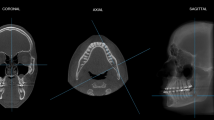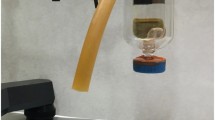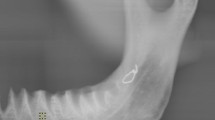Summary
The study presents quantitative computed tomography (QCT) as a noninvasiv method for analyzing the inner bone structure. Randomly selected mandibles from the osteological collection of the “Drago Perović” Institute of Anatomy, School of Medicine, Zagreb were CT-scanned in five bone areas. Analyzing the densitometry curve in two horizontal levels the relation between the compact and spongy bone and the total amount of bone substance in each area were determined. The smallest bone quantity was found in the area of the neck and angle of the mandible, the areas of most frequent bone fractures. The alveolar part of the bone, apart from the area of the angle, was considerably less thick than the base of the mandible. The compact bone was predominant in all CT-scans.
Résumé
Cette étude présente la tomographie quantitative assistée par ordinateur comme une méthode non exclusive d'analyse de la structure interne de l'os. Des mandibules choisies au hasard dans la collection ostéologique de l'institut “Drago Perović” d'Anatomie de l'Ecole de Médecine de Zagreb furent examinées en 5 positions par CT. A partir de l'examen de la courbe densitométrique en deux niveaux horizontaux, les relations entre les parties spongieuses et compactes de l'os d'une part, et la quantité totale de substance osseuse d'autre part, dans chaque zone, furent déterminées. La plus petite quantité de substance osseuse fut trouvée dans les zones du col et de l'angle de la mandibule, siège le plus fréquent des fractures de l'os. La partie alvéolaire de l'os, à l'exception de celle de l'angle, était considérablement moins épaisse que la base de la mandibule. L'os compact prédominait dans tous les examens par CT.
Similar content being viewed by others
References
Aljinovic N, Boric V (1986) Pregled metoda i ocjena uspjeha lijecenja prijeloma donje celjusti. Chir Maxillofac Plast 16: 21–4
Bagatin M (1985) Defekti orbite i kost simfize mandibule. Chir Maxillofac Plast 15: 25–29
Bagatin M (1985) Kost simfize mandibule u sekundarnim korekcijama nosa kod rascjepa. Chir Maxillofac Plast 15: 97–101
Bochlogyros PN (1985) A retrospective study of 1521 mandibular fractures. J Oral Maxillofac Surg 43: 597–99
Busuito MJ, Smith DJ, Robson MC (1986) Mandibular fractures in an urban trauma center. The Journal of Trauma 26: 826–829
Combelles R, Fabert G, Bayer E, Berranger A, De Saint-Martin R (1980) Etude durimetrique des os de la face. Ann Chir Plast 25: 305–310
Conroy GC, Vannier MW (1984) Noninvasive three-dimensional computer imaging of matrix filled fossil skulls by high-resolution computed tomography. Science 226: 456–458
Cupar I (1973) Kirurgija glave i vrata. Izdavacki zavod JAZU, Zagreb
Dingman RO, Natvig P (1964) Surgery of facial fractures. WB Saunders, Philadelphia
Donlon WC, Young P, Vassiliadis A (1988) Three-dimensional computed tomography for maxillo facial surgery: report of cases. J Oral Maxillofac Surg 46: 142–147
Ellis E, Moos KF, El-Attar A, Arbor A (1985) Ten years of mandubular fractures: an analysis of 2137 cases. Oral Surg Oral Med Oral Pathol 59: 120–129
Hounsfield GN (1980) Computed medical imaging. Science 210: 22–28
Lambert PM (1989) Three-dimensional computed tomography and anatomic replicans in surgical treatment planning. Oral Surg Oral Med Oral Pathol 68: 782–786
Melmed EP, Koonin AJ (1975) Fractures of the mandible. Plast et Reconstr Surg 56: 323–27
Nahser HC, Lohr E (1986) Möglichkeiten der hochauflösenden Computertomographie in der Diagnostik von Gesichtsschädelverletzungen. Radiologie 26: 412–415
Nikolic V, Hudec M (1988) Principi i elementi biomehanike. Skolska Knjiga, Zagreb
Olson RA, Fonseca RJ, Zeitler DL, Osbon DB (1982) Fractures of the mandible: a review of 580 cases. J Oral Maxillofac Surg 40: 23–28
Robb RA (1982) X-ray computed tomography. Am Rev Biophys Bioeng 11: 177–201
Ruff CB, Leo FP (1986) Use of computed tomography in skeletal structure research. Yearbook Phys Anthropol 29: 181–196
Sumner DR, Mockbee B, Morse K, Cram T, Pitt M (1985) Computed tomography and automated image analysis of prehistoric femora. Am J Phys Anthropol 68: 225–232
Tate JR, Cann CC (1982) High-resolution computed tomography for the comparative study of fossil and extant bone. Am J Phys Anthropol 58: 67–73
Tyndall DA, Matteson SR, Gregg JM (1983) Computed tomography in diagnosis and treatment of mandibular fractures. Oral Surg Oral Med Oral Pathol 56: 567–570
Wind J (198) Computerized x-ray tomography of fossil hominid skulls. Am J Phys Anthropol 63 : 265–282
Author information
Authors and Affiliations
Rights and permissions
About this article
Cite this article
Percač, S., Nikolić, V. Structural analysis of the mandible by quantitative computed tomography. Surg Radiol Anat 14, 155–158 (1992). https://doi.org/10.1007/BF01794893
Received:
Accepted:
Issue Date:
DOI: https://doi.org/10.1007/BF01794893




